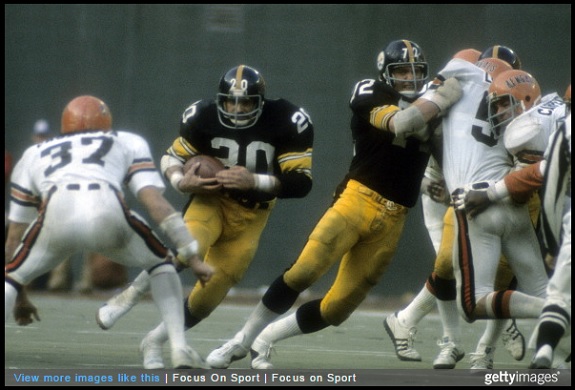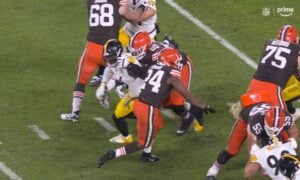Another series, a collaborative one, to take you through the remaining weeks of the offseason. Jon Ledyard and I will pick a side in choosing the greatest Pittsburgh Steelers at each position. Tell us who is right and who won the debate – those don’t have to be the same answer – in the comments.
To the fullbacks today. Jon makes his argument for Dan Kreider while I stick with Rocky Bleier.
JON:
Ever since I was a child, I loved football. Every cent I earned was spent acquiring football cards, until my brother and I could boast a collection of well over 35,000. At the time, collecting football cards was still a fairly common hobby, but the cards most people hoped to obtain were ones they could stand to profit handsomely from someday.
To be honest, that was never my mindset as a card collector. Instead I wanted the most diverse collection out there, I wanted to find the guys hardly anyone knew and continue to enhance my knowledge of the NFL. Back then we were still in dial-up internet phase so studying football cards was my best option to grow as a wanna-be sportswriter. I loved the unsung heroes of the league, the guys who did the dirty work night-in and night-out, sacrificing glory and praise for the betterment of the team. I felt that in some way by valuing their card, I was extending to them the respect that they might never get from the media, fans, or even other players and coaches. Maybe that was naive in some way, but as a young boy these players were simply the ones I gravitated to as my love for football grew and grew.
Dan Kreider was one of the those guys. One of the last of a dying breed of hard-nosed, blocking fullbacks whose specialty was smashing defenders face masks in, Kreider was the punishing type of player that a Pittsburgh fanbase grew to adore. His statistical impact is as minimal as it is insignificant, as Kreider was rarely asked to touch the ball on offense during his eight years with the Steelers. Instead he spend his time opening up holes for Jerome Bettis, Willie Parker, Duce Staley and others on his way to blocking for one of the top rushing offenses in the NFL year-after-year. Kreider was even voted rookie of the year by his fellow teammates in 2000, despite the fact that he was one of the team’s last additions as a free agent on draft day that spring.
An undrafted free agent out of the University of New Hampshire, Kreider is one of only 21 UNH players to ever snap on a chinstrap in the NFL, and he might be the most successful. The former Wildcat’s ten-year career dwarfed that of any of his 20 fellow graduates that made their way to the NFL, making him easily the longest-tenured UNH player ever in the league. Who would have thought that a fullback without any desirable athletics traits and limited rushing and receiving ability would become their college’s pride and joy on the biggest stage?
That was the kind of impact player Kreider was however. Just a tough, hard-working, gritty player who gained respect around the league for his class and tenacity in the trenches. He was the perfect Steeler, and while many others have had more significant statistical endeavors with the Black and Gold, Kreider’s selfless and vital blocking skills should be honored with a starting fullback spot on the All-Time Team in Pittsburgh. Lord knows his underrated contributions won’t ever get honored anywhere else.
ALEX:
Best fullback of all-time? As valiantly as Jon will debate it, there is no discussion. Rocky Bleier is the greatest fullback in Steelers’ history.
Statistically, who else could hold a candle to him? Over 3800 yards and 25 total touchdowns. Like Franco Harris, a key cog in the team’s first Super Bowl run, and his greatest postseason outputs, including a 98 yard performance over the hated Oakland Raiders and another 65 in the Super Bowl over the Minnesota Vikings.
Kreider rushed for 144 career yards with Pittsburgh. Bleier surpassed that in a single game in 1975.
But statistics aren’t always fair and Bleier blended as a running back along with his blocking dutires. The era makes numbers more generous to him than say, Kreider.
War injury aside, which we’ll get to, the fact Bleier was able to make a Chuck Noll roster is a statistical improbability. He cleaned house when he arrived in 1969. Heck, his first speech to his new team was not one of encouragement but impending doom.
From Gary Pomerantz’s book, Their Life’s Work.
“Noll said he had studied all the Steeler game films from 1968. He knew why Pittsburgh lost. It wasn’t attitude. The players just weren’t any good. They lacked size, speed, and worst of all, their techniques were tragically flawed. Noll explained his approach. He said he would not make pep talks before games…to transform the Steelers into a winner, he said, he would need to get rid of nearly every player.”
As Pomerantz points out, only five pre-Noll players were still on the team when they won their first Super Bowl in 1974. Bleier was one of them.
Of course, the only thing tougher to get through than on Noll’s roster was surviving Vietnam. You know the story and I won’t retell every detail again. Shot in the leg and riddled with over 100 pieces of shrapnel, football seemed out of the picture. Noll had the mindset of cutting him and in fact, Bleier was waived in 1971.
The body that was once declared 40% disabled was in the starting lineup in 1974, helping the team claim its first Super Bowl. Though it didn’t result in a championship, 1976 would be his finest year, teaming with Harris to become one of the few backfield tandems to rush for at least 1000 yards, Harris going for 1128.
Personal anecdotes don’t mean much, and this is certainly not the lead case, but I had the pleasure of meeting Bleier once while in college at Clarion, part of his motivational speaking tour. He gave us a few minutes, as nice and genuine as could be, before he walked to the stage to speak to the general audience. I was a bit starstruck, and probably asked stupid questions, but he didn’t seem to mind, lighting up as he talked about the Immaculate Reception.
There is no other Steeler at the position who can match his toughness, statistics, and odds overcome than number 20.








